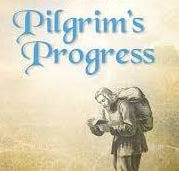A Pilgrim’s Progress, Part II
A Personal Pilgrimage for a Thanksgiving Observance
As a mid-west boy growing up in the “fifities” (last century), the annual Thanksgiving holiday was memorable in several ways. There was the question of whether it would be marked by the first snowfall of Winter, and sledding with our old wooden toboggan; and when the F.A.O. Schwarz Christmas toy catalog might soon appear in our mailbox.
There was also the traditional Thanksgiving dinner, with all the “fixin’s;” including my mother’s homemade turkey stuffing. But there was also the “stuff” of legend, such as the quaint image and tale of pilgrim’s who’d recently arrived at what was deemed to be their “promised land.” It included indigenous peoples who’d called those same shores their home for centuries, sitting down to a shared, thank-filled feast. No one appeared to be homeless, or hungry.
Part of those memories also included a children’s version of a tale once written more than three centuries earlier by John Bunyan, entitled, “A Pilgrim’s Progress.” The characters included one who had adopted the name, Christian; along with others he’d meet along his journey, who were given such allegorical names as Faithful, Hopeful, Evangelist, the tempter Apollyon, Obstinate, Pliable and Mr. Worldly Wiseman. In the story, Christian is on a pilgrimage; from the world we know to a destination yet to be found. As the original subtitle read, “From This World to That Which Is To Come.” Hmmmm …
One might assume from the storyline – which was based on the Christian scriptures to which the writer adhered – that he was referring to a heavenly realm, not of human origin, nor our own making. However, I would suggest instead that the pilgrim’s journey remains one of our own “ad-venturing.”
In Part I of this commentary , entitled “Deliverance, Without a Promised Land,” I shared the story of a seven day cycling trip I’d recently taken in northwest Spain and Portugal; a portion of which included the Camino de Santiago. It’s a path nearly 500 miles long that pilgrims have trekked for hundreds of miles for centuries to the Cathedral of Santiago de Compostela. However, the chosen cycling route took us in the opposite direction; leading me to wonder if there might be another kind of destination, metaphorically-speaking.
It was then that I recalled that brief passage from the canonical gospel of Matthew; about a wandering 1st-century Galilean peasant sage, named Jesus. When one sojourner proclaims he’ll follow him wherever he goes, Jesus replies, “Foxes have dens, and the birds of the sky have nests, but the son of Adam has nowhere to rest his head.” (Mt. 8:20)
I would humbly suggest the simple point being made in the sage’s reply was not simply an appeal to help the homeless who hungered for only one passing meal. But rather to envision another, greater worldly feast and place of our own making that everyone might call “home.” Such a homecoming is the “stuff” of that other kind a pilgrim’s journey the ancient sage once imagined; accompanied by such characters as Hopeful and Faithful.
“We shall not cease from exploration
And the end of all our exploring
Will be to arrive where we started
And know the place for the first time.” T.S. Eliot, The Four Quartets: Little Gidding (1941)
INTEREST OF NOTE: John Bunyan wrote “A Pilgrim’s Progress,” while imprisoned for violation of the Conventicle Act of 1664; which was an act of the Parliament of England that forbade any religious assembly of more than five people, outside the authority of the Church of England and the rubrics of the 1662 Book of Common Prayer. Those who might identify themselves as progressives in the Christian faith tradition beware …
© 2025 by John William Bennison, Rel.D. All rights reserved. This article should only be used or reproduced with proper credit. To read more commentaries by John Bennison from the perspective of a Christian progressive go to: http://wordsnways.com




John: this is a fantastic piece. You've really nailed how those old stories—Thanksgiving and Bunyan—get twisted into a challenge for us today. The whole idea that the "burden lifted" isn't about escaping this life, but about doing the hard work to make things right here, is spot on.
I love how you flipped the Camino
journey and then brought it home with that Jesus quote. It drives home the point that the true pilgrimage isn't a retreat; it's a collective responsibility to make that "worldly feast" happen for everyone. That means showing up every day and committing to be more human, kind, and courageous in how we treat each other.
That T.S. Eliot quote is the perfect capstone. It sums up the point that we go all the way around just to understand where we started. The real work is realizing that building a decent, equitable home for everyone is the only journey that truly matters. Great food for thought!
John, as always, you give us a lot to consider. You bring back my childhood and the best holiday celebrations. Blessings to you and your tribe!